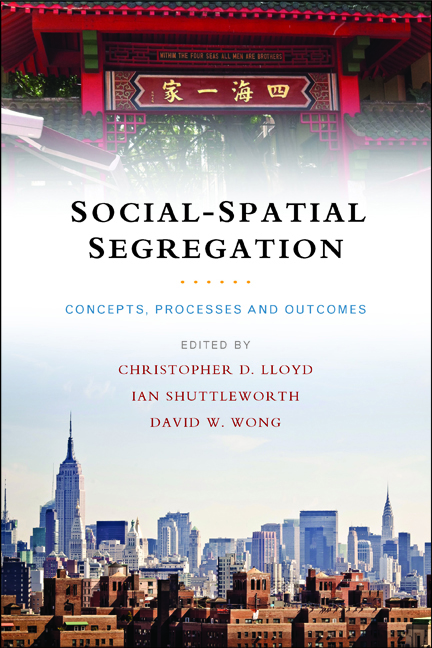four - Measuring neighbourhood segregation using spatial interaction data
Published online by Cambridge University Press: 04 March 2022
Summary
Introduction
The term ‘segregation’ implies a lack of mixing between members of different groups, and measures of segregation are often taken to indicate the degree of possible interactions between members of these groups (see Chapters Three and Five, this volume). Measures of segregation reflect spatial patterning in group distributions. The development of spatial measures, which make use of information on the relative spatial locations of zones, has been a particular focus in the academic literature concerned with improving methodologies for understanding segregation (see, for example, Morgan, 1983; Morrill, 1991; Wong, 1993, 2003; Reardon and O’Sullivan, 2004). Such measures overcome the spatial location independence of traditional measures (often expressed as the ‘checkerboard problem’). With traditional measures, if we have a set of zones containing members of two (or more) population subgroups, the spatial configuration of these zones will not alter the results and could be misleading. For example, if half of the zones are exclusively populated by members of group x and all other zones contain members only of group y, then the segregation index values will be the same irrespective of how much clustering or dispersion there is in the zones. That is, the index values will be identical, whether the x zones tend to cluster together in a group which is spatially distinct from the y zones, or if the x and y zones are intermixed. More recently, a variety of measures that enable the exploration of local variations in residential segregation have been presented (Wong, 2002; Feitosa et al, 2007; Lloyd and Shuttleworth, 2012), and local measures of spatial autocorrelation have been applied in the analysis of population clustering (Lloyd, 2010; Poulsen et al, 2010).
Conventional segregation measures, such as the index of dissimilarity (D), are aspatial and are intended to measure how the population is distributed across a set of zones, but they disregard the spatial relationships between zones. Thus, the use of such measures could be taken to imply that there is no interaction between zones. In other words, the model suggests that nobody interacts with anyone who lives outside of their zone. Spatial and local measures offer a conceptual improvement on standard aspatial measures in that they account for possible interactions between zones (see Chapter Three, this volume).
- Type
- Chapter
- Information
- Social-Spatial SegregationConcepts, Processes and Outcomes, pp. 65 - 90Publisher: Bristol University PressPrint publication year: 2014



